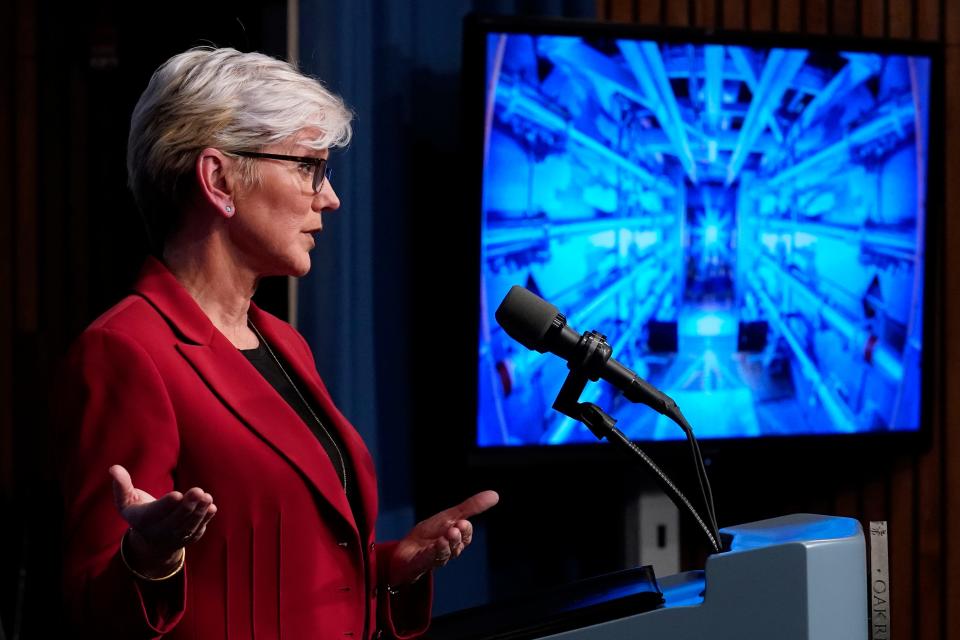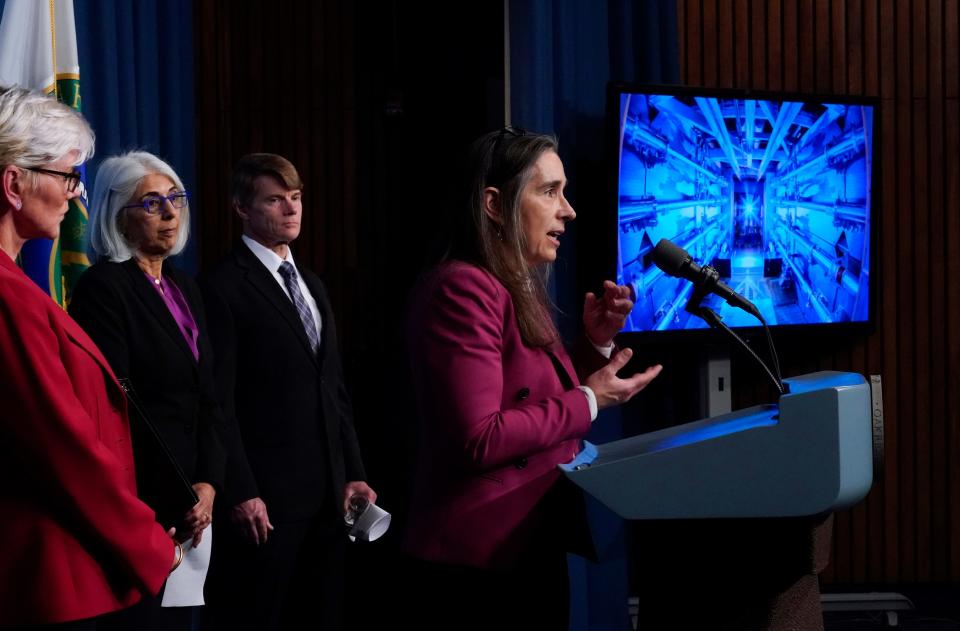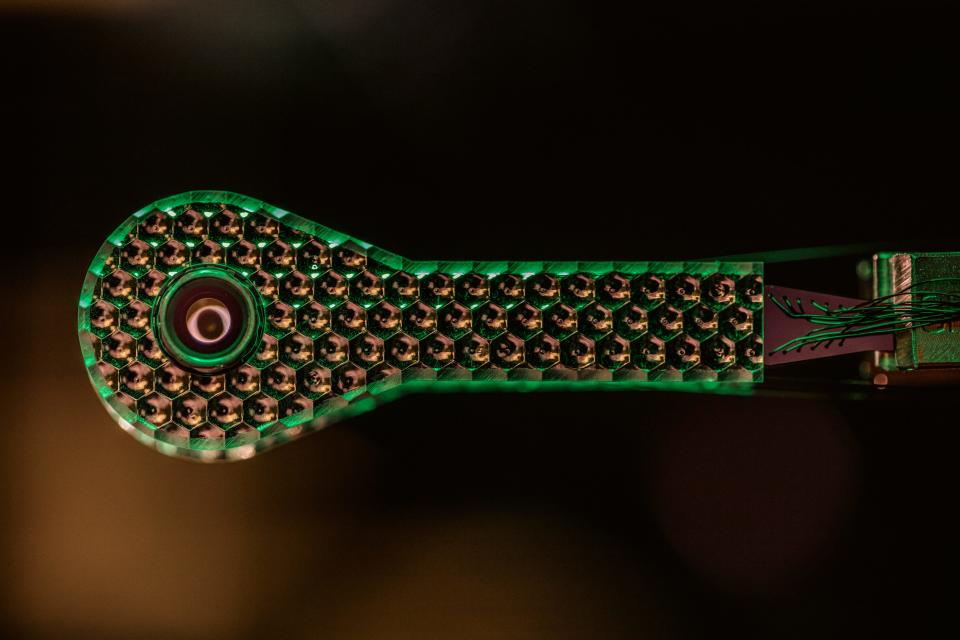Scientists achieve major advance in fusion energy that could provide clean, carbon-free power
- Oops!Something went wrong.Please try again later.
California scientists have achieved a major advance in fusion energy, a technology that could potentially provide clean, carbon-free power in years to come, the Department of Energy announced Tuesday.
The breakthrough was made at 1:03 a.m. on Dec. 5 at Lawrence Livermore National Laboratory's National Ignition Facility, 50 miles east of San Francisco. The work uses giant lasers to create heat and pressure like those found inside a star, enough to drive atoms together, releasing tremendous energy.
The advance described Tuesday was that researchers have been able to create more energy in the process than they put into it, what's known as "ignition." In a news conference, U.S. Secretary of Energy Jennifer Granholm described it as a "fusion breakthrough" that "will go down in the history books."

"It's a scientific milestone," said Arati Prabhakar, director of the White House Office of Science and Technology Policy. "It's also an engineering marvel beyond belief."
The hope is that in time, this process can be scaled up and done cheaply enough to create power that is carbon-free without the creation of radioactive waste, which is the challenge with fusion's more problematic sibling, nuclear fission.
How does climate change affect you?: Subscribe to the weekly Climate Point newsletter
READ MORE: Latest climate change news from USA TODAY
"Reaching ignition is an achievement that has come after over 60 years of global research,” said Jill Hruby, undersecretary for nuclear security and administrator for the National Nuclear Security Administration.
Tammy Ma, a fusion energy scientist who worked on the experiment, said she was standing in an airport waiting room when her boss called to tell her it had been a success. "I burst into tears. I was jumping up and down in the waiting area," she said.
The arrival of commercial fusion reactors that power cities will take years and the work of both public and private researchers, said Kim Budil, director of the Lawrence Livermore National Laboratory.
“I don’t want to give you a sense that we’re going to plug the NIF (National Ignition Facility at Livermore) into the grid. But this is the fundamental building block” of such work, she said.
How did they do it?
Fusion consists of combining two atoms together, a process that releases tremendous amounts of energy. It's the opposite of nuclear fission, in which atoms are blasted apart, also releasing energy.
At Livermore, the researchers focused 192 enormous lasers on a tiny metal cylinder no bigger than a pencil eraser, inside of which sat a tiny, peppercorn-sized pellet of fuel.
"The lasers smash the pellet in from all sides, which compresses it to the point you get the density and temperature to trigger fusion, similar to what you have in the sun," said Eric Gimon, a particle physicist and senior fellow with Energy Innovations, a nonpartisan energy and climate policy firm.
For the first time, researchers were able to get more energy out of the process than they put in – a proof of concept that this can, eventually, be an energy source. “About 2 megajoules in about 3 megajoules out, a gain of 1.5,” said Marvin Adams, the deputy administrator for defense programs at the National Nuclear Security Administration.
When the pressure and heat were sufficient, the atoms combine, releasing more energy than had been put into the process. That was the breakthrough – previously it always took more energy to make the process happen than came out. Now the calculus has changed, making energy production, eventually, possible.
"This is just the first step," Gimon said. "If you were climbing the Eifel Tower, this would only be the first landing."

How would a fusion reactor work?
After many scientific and engineering obstacles are overcome, the goal would be to create a power plant that used fusion to generate heat and electricity.
"The potential benefits are enormous clean, carbon, free, abundant, reliable energy capable of meeting the world's energy demands," said Ma, a plasma physicist and Lead for Inertial Fusion Energy on the project.
When the atoms are smashed together and combine, neutrons are released. These stream out of the reaction chamber and can be used to heat a liquid, probably water, to create steam. This steam in turn could be used to power turbines that would produce electricity, said Alain Brizard, a theoretical fusion expert at Saint Michael's College in Vermont who was not part of the project.
The entire process produces "an order of magnitude" less radioactive material than a nuclear power plant that splits atoms through fission, he said.
The material of the reactor itself would become slightly radioactive, but with a very short half-life of a few days to a few weeks, unlike the products from nuclear power plants, some of which can require thousands of years to become safe, according to the Nuclear Regulatory Commission.
Fusion power plants would also not have the possibility of catastrophic failures and meltdowns such as can accidentally occur in nuclear plants, as they did in Chernobyl or Fukushima.
With fusions, the entire process stops as soon as you turn off the laser, Brizard said.
Russia's war renews nuclear disaster fears: What to know about radiation

Don't count on fusion power anytime soon
The road from the tiny experiment in Livermore to fusion power plants is long, experts say. The process will have to be repeated, tested, scaled up and made economically viable, which will take years if not decades.
"I would say that in the next 20 years we would have a commercially operating nuclear fusion reactor," Brizard said.
These are going to be big plants – the size of today's power plants.
"It's not going to be like Mr. Fusion in 'Back to the Future II,'" said Brizard, referencing the coffee-can-sized fusion reactor that fueled the DeLorean at the end of the film.
The work is a prime example of the painstaking time involved in getting scientific breakthroughs. It was decades in the making and is an excellent example of the power of serious, deep, long-term scientific research and development, the kind that can only be funded by the public sector, experts said.
"The science and technology challenges on the path to fusion energy are daunting, but making the seemingly impossible possible is when we're at our very best," said Budil. "This is how we do really big, hard things."
Read more about renewable energy from USA TODAY:
First offshore wind power sites auctioned off California's coast
Wind, solar power account for record 13% of U.S. energy in 2021
US renewable energy hit record 28% in April. What's driving the change?
What this means for climate change and renewables
The breakthrough is not the answer to climate change and doesn't mean work to shift to carbon-neutral energy production can stop.
"There’s no chance that this will be commercialized by 2030 and we have to cut our country's emissions 50% by 2005 levels by then if we hope to keep temperature rise at a relatively safe level," said Michael O'Boyle, director of electricity policy at Energy Innovation.
The world will need to stay focused on adding more diversity to the global energy mix, like deploying already mature carbon-neutral technologies such as wind, solar, hydro and nuclear, and continuing to explore emerging technologies like geothermal power and offshore floating wind.
"This is definitely good news that we’ve got another potentially promising option in the long run but we’re just going to have to wait and see how things go," O'Boyle said.
Business implications
A few dozen startups are already working on commercializing fusion energy. Others are likely to capitalize on it once it becomes available.
Connecticut company FuelCell Energy, for instance, now develops electrolyzers to make hydrogen as a fuel source. Now, the company works with the Idaho National Laboratory to use nuclear power to generate hydrogen, but fusion offers even more potential, said Tony Leo, the company's chief technology officer.
"This could be very inexpensive power," he said, potentially fueling airplanes and cars. "As a person in an industry that uses power and as a consumer, there's a benefit right there.
"It's not going to change the energy landscape tomorrow, but it will in one to two decades," Leon added.
Scientific details
The reaction required scientists to compress the fuel to pressures, temperatures and densities higher than those at the center of the sun, said Alex Zylstra, the principal experimentalist on the project.
To achieve ignition requires reaching temperatures over 100 million degrees, "10-times hotter than the sun, and the entire reaction occurs in a fraction of a nanosecond, a billion times faster than you can blink your eye," said Arthur Pak, a staff scientist at the National Ignition Facility.
Lawrence Livermore's laser, which is based on now outdated technology, is the size of three football fields and has the capacity to produce 500 trillion watts of energy, said Jean-Michel Di Nicola, chief engineer for the laser system. "For a very short amount of time – we are talking about only a few billionths of a second – it exceeds the entire U.S. power grid."
There are still tiny flaws in the shells used to house the experiment, said Michael Stadermann, the target fabrication program manager at Lawrence Livermore. Minimizing those flaws, which are now the size of bacteria, will help improve the efficiency of future fusion reactions.
"We should be able to reproduce or even improve on this," he said.
The team has several methods of checking its results, in part by trapping the neutrons released by the experiment. Outside experts also spent much of the last week reviewing the figures to confirm that government scientists had achieved ignition.
This article originally appeared on USA TODAY: Fusion energy sees major advance: What does it mean for clean power?

